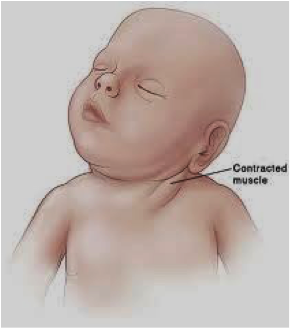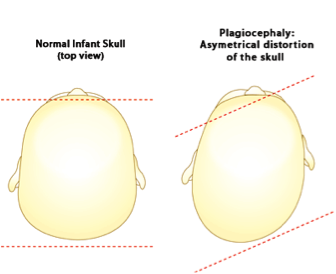
Physical Therapy for Torticollis

Most have known babies who always seem to have a “cute head tilt” to one side, but did you know that this could actually be suggestive of a relatively common pediatric musculoskeletal condition called torticollis? As a pediatric physical therapist, I am often involved in the screening and treatment of torticollis and hope that this blog can educate the family, friends, and caregivers of little ones with this very treatable diagnosis.
What is Torticollis?
While there are several forms of this condition, the most common is congenital muscular torticollis (CMT). This occurs when a muscle on the side of the neck, the sternocleidomastoid, becomes tight and/or thickened. The same muscle on the other side of the neck then becomes overstretched and weakened. This results in a child’s head position being tilted towards one shoulder with the chin turned towards the other. It can either be present at birth or develop within the first few months of life. While the exact cause of CMT is unknown, most medical professionals agree that it is due to positioning of the baby in utero. If the condition develops after birth, it is most likely due to sleeping or remaining in one position for a prolonged period of time.
Why Does it Matter?
 Torticollis can lead to more than just a preferential head posture. As the baby keeps his or her head in this one position, other changes are occurring both physically and developmentally. Associated conditions that may occur due to CMT include:
Torticollis can lead to more than just a preferential head posture. As the baby keeps his or her head in this one position, other changes are occurring both physically and developmentally. Associated conditions that may occur due to CMT include:
- Plagiocephaly (flattening of the skull) and facial asymmetries
- Strength imbalances due to preferential use of one side of the body versus the other (the side he or she tends to look towards)
- Scoliosis (curvature of the spine)
- Developmental Hip Dysplasia (when the top of the thigh bone does not sit securely within the hip socket)
- Delay in fine and gross motor skills as well as the meeting of developmental milestones
- Delay in cognitive development, self-awareness, and social interaction due to limited ability to see, hear, and interact with surroundings
- Balance and postural control difficulties
The Importance of Early Intervention
 Pediatricians begin screening for signs and symptoms of torticollis during baby wellness visits and may officially make the diagnosis as early as 1-2 months of age. It is imperative that if any postural asymmetries persist, a referral for physical therapy intervention is made as early as possible. Research has proven that early intervention is greatly beneficial. Per the Clinical Practice Guidelines for treatment of torticollis (Kaplan et al 2013), if initiated before 1 month of age, 98% of infants achieve near normal neck range of motion within 1.5 months. However, waiting until after 1 month of age prolongs intervention to about 6 months. Delaying until after 6 months can require treatment as long as 9 to 10 months, with progressively fewer infants achieving full neck range of motion. Delaying treatment also increases the risk of the child developing the associated conditions outlined above.
Pediatricians begin screening for signs and symptoms of torticollis during baby wellness visits and may officially make the diagnosis as early as 1-2 months of age. It is imperative that if any postural asymmetries persist, a referral for physical therapy intervention is made as early as possible. Research has proven that early intervention is greatly beneficial. Per the Clinical Practice Guidelines for treatment of torticollis (Kaplan et al 2013), if initiated before 1 month of age, 98% of infants achieve near normal neck range of motion within 1.5 months. However, waiting until after 1 month of age prolongs intervention to about 6 months. Delaying until after 6 months can require treatment as long as 9 to 10 months, with progressively fewer infants achieving full neck range of motion. Delaying treatment also increases the risk of the child developing the associated conditions outlined above.
Physical Therapy Treatment
 A physical therapist is going to work closely with the child’s caregivers to develop and reach mutual goals in regards to neck range of motion, strength, and developmental milestones. The treatment plan may include:
A physical therapist is going to work closely with the child’s caregivers to develop and reach mutual goals in regards to neck range of motion, strength, and developmental milestones. The treatment plan may include:
- Stretching, range of motion, and strengthening exercises to address muscular imbalance
- Improving postural control and symmetry
- Improving balance and body alignment
- Promoting development of age-appropriate fine and gross motor skills
- Educating caregivers on a home exercise program as well as play activities and positioning tools to compliment the treatment being provided by the therapist
While CMT is by far the most common type of torticollis found in children, there are other forms as well as other underlying medical conditions which display similar presentations. As such, it is always important to consult a pediatrician with any concerns regarding a child’s development.


